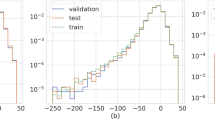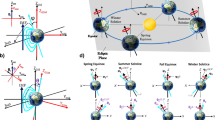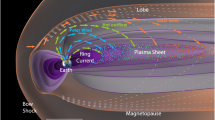Abstract
IT has long been known that geomagnetic disturbances tend to recur after ∼27 d (refs 1–4). More recently, this effect has been associated with the rotation of the interplanetary magnetic field5–8, and some evidence for a relation between the interplanetary magnetic field and terrestrial weather has also been found9,10. The interplanetary magnetic field is usually characterised by either two or four sectors, and this pattern rotates with a fairly well defined period of ∼27.1±0.1 d (ref. 7). Such a periodicity leads naturally to the use of spectral analysis as an independent test of the reported association between the interplanetary magnetic field structure and terrestrial weather. We have obtained data on the geomagnetic activity index Ap for the 1964–70 from the National Oceanic and Atmospheric Administration and the vorticity area index used by Wilcox and his colleagues in their analysis9 for the same interval. We wish to form spectra of both time series and examine the spectra for common features which may be associated with solar related phenomena. Specifically we look for peaks in the power spectra of both time series with periods near 27.1 d.
This is a preview of subscription content, access via your institution
Access options
Subscribe to this journal
Receive 51 print issues and online access
$199.00 per year
only $3.90 per issue
Buy this article
- Purchase on SpringerLink
- Instant access to full article PDF
Prices may be subject to local taxes which are calculated during checkout
Similar content being viewed by others
References
Maunder, E. W., Mon. Not. R. astr. Soc. 65, 2–34 (1904).
Maunder, E. W., Mon. Not. R. astr. Soc., 65, 538–559 (1905).
Chree, C., and Stagg, J. M., Phil. Trans. R. Soc., A227, 21–62 (1927).
Bartels, J., Terr. Magn. atmos. Elect., 37, 1–55 (1932).
Ness, N. F., and Wilcox, J. M., Solar Phys., 2, 351–359 (1967).
Schatten, K. E., and Wilcox, J. M., J. geophys. Res., 72, 5185–5191 (1967).
Wilcox, J. M., Space Sci. Rev., 8, 258–328 (1968).
Wilcox, J. M., and Coburn, D. S., J. geophys. Res., 77, 751–756 (1972).
Wilcox, J. M., Scherrer, P. H., Svalgaard, L., Roberts, W. O., and Olson, R. H., Science, 180, 185–186 (1973).
Wilcox, J. M., Svalgaard, L., and Scherrer, P. H., Nature, 255, 539–540 (1975).
Rao, C. R., Linear Statistical Inference and Its Applications (2nd edn), 238 (John Wiley and Sons, New York, 1973).
Abramowitz, M., and Stegun, I. A., Handbook of Mathematical Functions, 946 (US National Burea of Standards Applied Mathematics Series, 1970).
Abramowitz, M., and Stegun, I. A., Handbook of Mathematical Functions, 985–989 (US National Burea of Standards Applied Mathematics Series, 1970).
Newton, H. W., and Nunn, M. L., Mon. Not. R. astr. Soc., 111, 413–421 (1951).
Graf, W., Solar Phys., 37, 257–260 (1974).
Author information
Authors and Affiliations
Rights and permissions
About this article
Cite this article
KNIGHT, J., STURROCK, P. Solar activity geomagnetic field and terrestrial weather. Nature 264, 239–240 (1976). https://doi.org/10.1038/264239a0
Received:
Accepted:
Issue date:
DOI: https://doi.org/10.1038/264239a0
This article is cited by
-
The Life and Times of a Dissident Scientist
Solar Physics (2017)
-
Solar activity and Indian weather/climate
Journal of Earth System Science (1981)



